December 14, 2009 8:16 AM CST
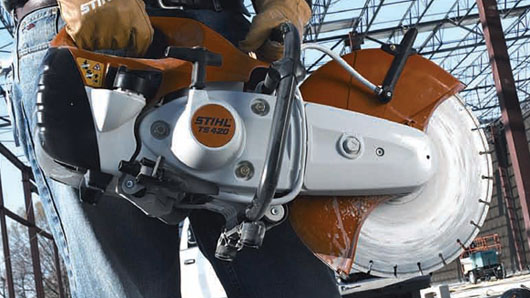
Sometimes, products are designed with a lot of bells and whistles, but marginal benefits. These power cutters, masonry saws, and cut off machines are different. They’re loaded with technologies to protect the engine, cut 28-inch masonry materials, or increase run times. Masonry contractors will also benefit from less vibration, more power, and better performance. Here’s a look at what contractors can expect.
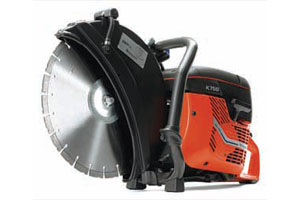
Husqvarna Construction Products North America in Olathe, Kan., figured out how to eliminate the problem of workers burning up engines by using the wrong fuel. The five-horsepower engines on the 12- and 14-inch K750 power cutters have Oil Guard, which protects the engine from improper fuel.
“If a hardscaper is using temporary labor, and there’s a lot of gas on the jobsite – gas and oil mixtures, regular gas, diesel – you don’t have to worry about the wrong gas being used,” says Mike Ward, Husqvarna product manager for power cutters.
A sensor detects if the engine has the correct oil, based on the dye concentrate in the two-cycle oil and gas mixture, Ward says. If the wrong oil or no oil is used, the engine won’t run above an idle.
“The biggest problem that we run into with high-speed saws is when the saws don’t run on the gas and oil mix. It’s a very expensive repair. The cylinders are ruined,” says Andy Lundberg, product manager for tile and masonry for Husqvarna. “You can’t, no matter how hard you try, ruin these [K750] saws. They have to have oil to run.”
Ward says Husqvarna also launched an electric power cutter that’s capable of wet cutting. The K3000 Electric has GFCI (ground-fault circuit interrupter) protection built into the machine for safety and convenience.
“You can cut wet, which gives you dust suppression, so you can cut indoors,” Ward says. Strategically placed nozzles shoot water onto the blade, which gives the blade the correct amount of water needed for cutting. “You have less slurry to clean up at the end of the day.”
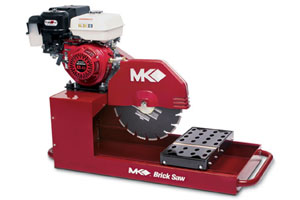
At least one manufacturer is responding to the popularity of large pavers by offering a powerful saw capable of cutting oversized, thick materials. Earlier this year, MK Diamond Products Inc. unveiled the MK-1280 that features a 16-inch blade that cuts to a depth of six inches, says Brian Delahaut, VP of the Torrance, Calif.-based company.
“The thing we started to notice from the user side is that in the paver market, we’re seeing larger pavers,” Delahaut says, noting that masonry contractors were having trouble cutting the pavers on traditional saws. “Our saw is designed for cutting larger pavers, brick, and other popular masonry materials.”
The saw cuts a length of up to 28 inches and can cut masonry materials either wet or dry, he says. A nine-horsepower Honda gas engine powers the saw, although a two-horsepower Baldor electric motor is also available.
“The engine has a lot of power for the customer to cut pavers,” Delahaut says.
Design changes allowed MK Diamond to produce the saw less expensively than other masonry saws, he says. The cutting head is stationary, which eliminates the need for the user to pull down the blade to the material. Repeatedly pulling down the blade can cause carpal tunnel, in some cases.
“One thing we heard from users is they were tired of pulling the head down,” Delahaut says. “This has a fixed head, so you push the material with both hands, which makes it much safer.”
“This engine technology, coupled with a larger fuel tank, also increases the runtime by 20 percent compared to the TS 400,” he says. “A four spring anti-vibration system reduces vibration by 43 percent. This reduction in vibration makes these units more comfortable to use and also reduces operator fatigue.”
With the X2 system, masonry contractors don’t have to worry about cleaning the filter everyday, Hanks points out.
“The filters on these units shouldn’t be cleaned at all but replaced when the operator notices a loss in power,” he says. “The filter can go up to a year before being replaced, depending on hours and type of use. Because of the abrasive nature of concrete dust, cleaning the filters can actually damage the units by allowing this abrasive dust into the cylinder.”
“While the operator is using the saw, he can change the speed to match the hardness of the material,” Delahaut says.
The saw’s ergonomically designed handle reduces operator fatigue, a heavy-duty conveyor cart supports heavy weight, and an open back allows cuts up to 20-inches long, Delahaut says. “We did a lot of work to develop the saw and make it safer for the operator.”
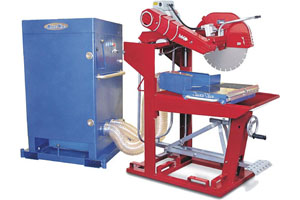
Protecting workers from silica dust is a priority for the masonry industry, and Masonry Tec Products has a solution. The company’s JackVac dust collection systems attach to masonry saws to contain more than 95 percent of the dust.
“The benefit is it allows you to dry cut,” says Paul Guth, VP for the Moreno Valley, Calif.-based company. “You can cut indoors. If you need to dry cut because of freezing conditions or wet cutting is not an option, you can."
The JackVac1000 has an integrated saw stand, a dust collection hood, and connects to 14-inch masonry saws, Guth says. The unit, available in gas or electric, has been redesigned over the last year.
“It’s about half the size and weight,” he says. “It’s much more portable.”
The JackVac 2000 attaches to 20-inch masonry saws. Guth says his systems let masonry workers dry cut materials with minimal exposure to silica dust.
“[Masonry contractors] realize silica dust is a liability. There are legal ramifications down the road from breathing the dust,” he says. “The real problem is if the contractors want to dry cut, then they need dust collection.”
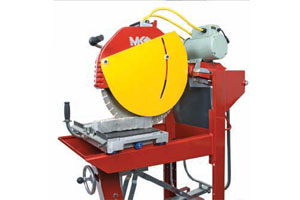
Masonry contractors who want to cut with angle grinders have a line of seven- and nine-inch models to choose from, courtesy of Mount Prospect, Ill.-based Bosch Power Tools and Accessories. The company’s 1900 series grinders are powered by four-horsepower motors that are 15 percent more efficient.
“We redesigned the motor to make it more efficient, not so much to get more power, but to make the tool weigh less and still get the same power,” says Ryan Anderson, product manager for angle grinders.
The 11.8 lb. grinders weigh 20 percent less than comparably sized grinders, Anderson says. The grinders have also reduced vibration by 50 percent for better ergonomics.
“We separated the handle from the tool, as much as possible ,” Anderson says. “We’ve made it a more efficient tool. You can use it for longer periods if time without so much fatigue.”
One of the grinders, model 1994-6, offers a handle that rotates 90 degrees in either direction for better control, Anderson says. “This makes it comfortable to use when making awkward cuts.”
Masonry Saws and Cutting Machines
Cutting-edge technology and better designs are changing the landscape for saws
By Brett Martin

The Stihl TS 420 is equipped with a piston-controlled, stratified-charge engine that reduces emissions by 44 percent.
Sometimes, products are designed with a lot of bells and whistles, but marginal benefits. These power cutters, masonry saws, and cut off machines are different. They’re loaded with technologies to protect the engine, cut 28-inch masonry materials, or increase run times. Masonry contractors will also benefit from less vibration, more power, and better performance. Here’s a look at what contractors can expect.
Smart Engines Eliminate Costly Repairs

Husqvarna's 12- and 14-inch K750 power cutters have Oil Guard, which protects the engine from improper fuel.
“If a hardscaper is using temporary labor, and there’s a lot of gas on the jobsite – gas and oil mixtures, regular gas, diesel – you don’t have to worry about the wrong gas being used,” says Mike Ward, Husqvarna product manager for power cutters.
A sensor detects if the engine has the correct oil, based on the dye concentrate in the two-cycle oil and gas mixture, Ward says. If the wrong oil or no oil is used, the engine won’t run above an idle.
“The biggest problem that we run into with high-speed saws is when the saws don’t run on the gas and oil mix. It’s a very expensive repair. The cylinders are ruined,” says Andy Lundberg, product manager for tile and masonry for Husqvarna. “You can’t, no matter how hard you try, ruin these [K750] saws. They have to have oil to run.”
Ward says Husqvarna also launched an electric power cutter that’s capable of wet cutting. The K3000 Electric has GFCI (ground-fault circuit interrupter) protection built into the machine for safety and convenience.
“You can cut wet, which gives you dust suppression, so you can cut indoors,” Ward says. Strategically placed nozzles shoot water onto the blade, which gives the blade the correct amount of water needed for cutting. “You have less slurry to clean up at the end of the day.”
Increased Cutting Capacity For Large Pavers

The MK-1280 from MK Diamond Products, Inc. features a 16-inch blade that cuts to a depth of six inches.
“The thing we started to notice from the user side is that in the paver market, we’re seeing larger pavers,” Delahaut says, noting that masonry contractors were having trouble cutting the pavers on traditional saws. “Our saw is designed for cutting larger pavers, brick, and other popular masonry materials.”
The saw cuts a length of up to 28 inches and can cut masonry materials either wet or dry, he says. A nine-horsepower Honda gas engine powers the saw, although a two-horsepower Baldor electric motor is also available.
“The engine has a lot of power for the customer to cut pavers,” Delahaut says.
Design changes allowed MK Diamond to produce the saw less expensively than other masonry saws, he says. The cutting head is stationary, which eliminates the need for the user to pull down the blade to the material. Repeatedly pulling down the blade can cause carpal tunnel, in some cases.
“One thing we heard from users is they were tired of pulling the head down,” Delahaut says. “This has a fixed head, so you push the material with both hands, which makes it much safer.”
New Engine Technology Improves Performance
Cut-off machines from STIHL Inc., in Virginia Beach, Va., offer the company’s X2 air filtration system that delivers 99.96 percent pure air to the carburetor, says Adam Hanks, product manager, industrial products. Originally developed for larger cut-off machines, the X2 system is now available on the TS 410 and TS 420, which are equipped with a piston-controlled, stratified-charge engine that reduces emissions by 44 percent, compared to the TS 400.“This engine technology, coupled with a larger fuel tank, also increases the runtime by 20 percent compared to the TS 400,” he says. “A four spring anti-vibration system reduces vibration by 43 percent. This reduction in vibration makes these units more comfortable to use and also reduces operator fatigue.”
With the X2 system, masonry contractors don’t have to worry about cleaning the filter everyday, Hanks points out.
“The filters on these units shouldn’t be cleaned at all but replaced when the operator notices a loss in power,” he says. “The filter can go up to a year before being replaced, depending on hours and type of use. Because of the abrasive nature of concrete dust, cleaning the filters can actually damage the units by allowing this abrasive dust into the cylinder.”
Matching the Saw Speed to the Material
Earlier this year, MK Diamond updated one of its popular block cutting saws, the MK-5010. The saw has a 24-inch blade, a guard that protects the entire blade, and a variable speed motor.“While the operator is using the saw, he can change the speed to match the hardness of the material,” Delahaut says.
The saw’s ergonomically designed handle reduces operator fatigue, a heavy-duty conveyor cart supports heavy weight, and an open back allows cuts up to 20-inches long, Delahaut says. “We did a lot of work to develop the saw and make it safer for the operator.”
Containing Dust While Dry Cutting

Masonry Tec Products' JackVac1000 has an integrated saw stand, a dust collection hood.
“The benefit is it allows you to dry cut,” says Paul Guth, VP for the Moreno Valley, Calif.-based company. “You can cut indoors. If you need to dry cut because of freezing conditions or wet cutting is not an option, you can."
The JackVac1000 has an integrated saw stand, a dust collection hood, and connects to 14-inch masonry saws, Guth says. The unit, available in gas or electric, has been redesigned over the last year.
“It’s about half the size and weight,” he says. “It’s much more portable.”
The JackVac 2000 attaches to 20-inch masonry saws. Guth says his systems let masonry workers dry cut materials with minimal exposure to silica dust.
“[Masonry contractors] realize silica dust is a liability. There are legal ramifications down the road from breathing the dust,” he says. “The real problem is if the contractors want to dry cut, then they need dust collection.”
High-end, Lighter Weight Grinders

The MK-5010 from MK Diamond Products, Inc. has a 24-inch blade, a guard that protects the entire blade, and a variable speed motor.
“We redesigned the motor to make it more efficient, not so much to get more power, but to make the tool weigh less and still get the same power,” says Ryan Anderson, product manager for angle grinders.
The 11.8 lb. grinders weigh 20 percent less than comparably sized grinders, Anderson says. The grinders have also reduced vibration by 50 percent for better ergonomics.
“We separated the handle from the tool, as much as possible ,” Anderson says. “We’ve made it a more efficient tool. You can use it for longer periods if time without so much fatigue.”
One of the grinders, model 1994-6, offers a handle that rotates 90 degrees in either direction for better control, Anderson says. “This makes it comfortable to use when making awkward cuts.”
About the Author
Brett Martin is a freelance writer located in Shakopee, Minn. with several years of construction and writing experience.


















